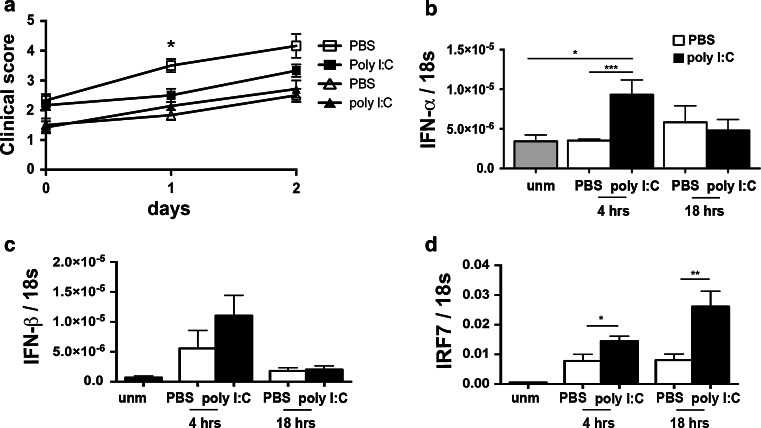Fig. 4.
Intrathecal induction of IFN-α/β inhibited EAE. C57BL/6 and IFNAR1-deficient mice were immunized with MOG p35-55 and administered poly I:C or PBS by injection into the cisterna magna on the first day (day 0) with symptoms of EAE. a Shows pooled data from four independent experiments (n = 22). The mean clinical score did not change until the 48 h time point in mice that had received poly I:C (closed squares), whereas the control PBS-treated mice showed a significant increase in clinical score at both 24 (P < 0.01) and 48 h (P < 0.001) (open squares). The mean clinical score increased significantly at 24 (P < 0.05) and 48 h (P < 0.05) in IFNAR1-deficient mice (n = 7) that were given intrathecal poly I:C (closed triangles). Clinical scores at 24 h in PBS- and poly I:C-treated C57BL/6 mice were significantly different from each other (P < 0.05), whereas there was no difference between PBS- and poly I:C-treated IFNAR1-deficient mice at 24 h. b IFN-α message was significantly increased at 4 h after poly I:C treatment of mice with EAE. Mice with EAE had elevated levels of IFN-β (P < 0.05) (c) and IRF7 (P < 0.005) (d) in the CNS compared to unmanipulated (unm) mice. Levels of mRNA for IFN-β were increased at 4 h after poly I:C treatment of mice with EAE but not to significance (c). Levels of IRF7 message were significantly increased at 4 and 18 h post-poly I:C treatment (d). Data were analyzed by two-tailed nonparametric Student’s t test followed by Mann–Whitney test. Results are presented as mean ± SEM. *P < 0.05, **P < 0.01

